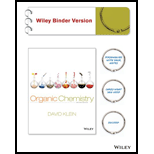
(a)
Interpretation:
Major and minor product should be drawn for the given substrates in E2 elimination reaction.
Concept introduction:
- Elimination reaction: In elimination reaction, two substituents are removed from the substrate to give the product in presence of base. Elimination reactions are two types, E1 and E2.
- E1 reaction: elimination follows stepwise mechanism.
- E2 reaction: elimination follows concerted pathway of mechanism.
- Elimination of compound in presence of bulky base leads to less substituted
alkene , in presence of strong base (not bulky) leads to more substituted alkene.
(b)
Interpretation:
Major and minor product should be drawn for the given substrates in E2 elimination reaction.
Concept introduction:
- Elimination reaction: In elimination reaction, two substituents are removed from the substrate to give the product in presence of base. Elimination reactions are two types, E1 and E2.
- E1 reaction: elimination follows stepwise mechanism.
- E2 reaction: elimination follows concerted pathway of mechanism.
- Elimination of compound in presence of bulky base leads to less substituted alkene, in presence of strong base (not bulky) leads to more substituted alkene.
(c)
Interpretation:
Major and minor product should be drawn for the given substrates in E2 elimination reaction.
Concept introduction:
- Elimination reaction: In elimination reaction, two substituents are removed from the substrate to give the product in presence of base. Elimination reactions are two types, E1 and E2.
- E1 reaction: elimination follows stepwise mechanism.
- E2 reaction: elimination follows concerted pathway of mechanism.
- Elimination of compound in presence of bulky base leads to less substituted alkene, in presence of strong base (not bulky) leads to more substituted alkene.
(d)
Interpretation:
Major and minor product should be drawn for the given substrates in E2 elimination reaction.
Concept introduction:
- Elimination reaction: In elimination reaction, two substituents are removed from the substrate to give the product in presence of base. Elimination reactions are two types, E1 and E2.
- E1 reaction: elimination follows stepwise mechanism.
- E2 reaction: elimination follows concerted pathway of mechanism.
- Elimination of compound in presence of bulky base leads to less substituted alkene, in presence of strong base (not bulky) leads to more substituted alkene.
Answer:

Explanation:
To find: the products for the given alkyl halide during E2 reaction.
Given substrate is drawn below.

E2 elimination product for above substrate is drawn below.

In the given elimination reaction used base is sodium ethoxide (NaoEt), which is strong base. Therefore, most substituted alkene is major product while the less substituted alkene is minor product.
(e)
Interpretation:
Major and minor product should be drawn for the given substrates in E2 elimination reaction.
Concept introduction:
- Elimination reaction: In elimination reaction, two substituents are removed from the substrate to give the product in presence of base. Elimination reactions are two types, E1 and E2.
- E1 reaction: elimination follows stepwise mechanism.
- E2 reaction: elimination follows concerted pathway of mechanism.
- Elimination of compound in presence of bulky base leads to less substituted alkene, in presence of strong base (not bulky) leads to more substituted alkene.
(f)
Interpretation:
Major and minor product should be drawn for the given substrates in E2 elimination reaction.
Concept introduction:
- Elimination reaction: In elimination reaction, two substituents are removed from the substrate to give the product in presence of base. Elimination reactions are two types, E1 and E2.
- E1 reaction: elimination follows stepwise mechanism.
- E2 reaction: elimination follows concerted pathway of mechanism.
- Elimination of compound in presence of bulky base leads to less substituted alkene, in presence of strong base (not bulky) leads to more substituted alkene.
Want to see the full answer?
Check out a sample textbook solution
Chapter 8 Solutions
Organic Chemistry, Binder Ready Version
 ChemistryChemistryISBN:9781305957404Author:Steven S. Zumdahl, Susan A. Zumdahl, Donald J. DeCostePublisher:Cengage Learning
ChemistryChemistryISBN:9781305957404Author:Steven S. Zumdahl, Susan A. Zumdahl, Donald J. DeCostePublisher:Cengage Learning ChemistryChemistryISBN:9781259911156Author:Raymond Chang Dr., Jason Overby ProfessorPublisher:McGraw-Hill Education
ChemistryChemistryISBN:9781259911156Author:Raymond Chang Dr., Jason Overby ProfessorPublisher:McGraw-Hill Education Principles of Instrumental AnalysisChemistryISBN:9781305577213Author:Douglas A. Skoog, F. James Holler, Stanley R. CrouchPublisher:Cengage Learning
Principles of Instrumental AnalysisChemistryISBN:9781305577213Author:Douglas A. Skoog, F. James Holler, Stanley R. CrouchPublisher:Cengage Learning Organic ChemistryChemistryISBN:9780078021558Author:Janice Gorzynski Smith Dr.Publisher:McGraw-Hill Education
Organic ChemistryChemistryISBN:9780078021558Author:Janice Gorzynski Smith Dr.Publisher:McGraw-Hill Education Chemistry: Principles and ReactionsChemistryISBN:9781305079373Author:William L. Masterton, Cecile N. HurleyPublisher:Cengage Learning
Chemistry: Principles and ReactionsChemistryISBN:9781305079373Author:William L. Masterton, Cecile N. HurleyPublisher:Cengage Learning Elementary Principles of Chemical Processes, Bind...ChemistryISBN:9781118431221Author:Richard M. Felder, Ronald W. Rousseau, Lisa G. BullardPublisher:WILEY
Elementary Principles of Chemical Processes, Bind...ChemistryISBN:9781118431221Author:Richard M. Felder, Ronald W. Rousseau, Lisa G. BullardPublisher:WILEY





